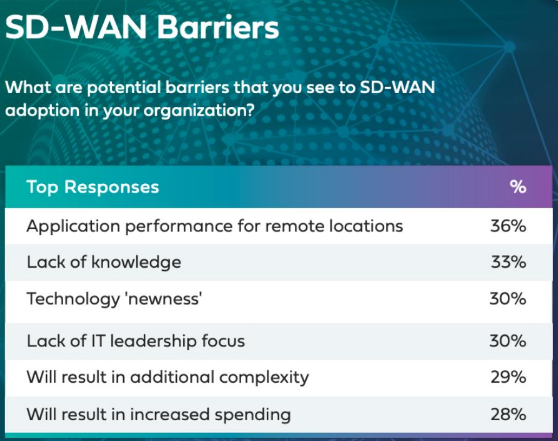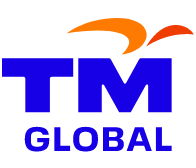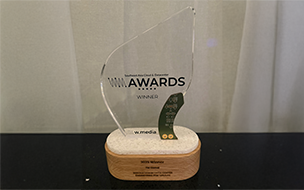SD WAN is taking the enterprise by storm. Read on to find the easiest explanation of what SD WAN is, the challenges it solves, and discover the speed and intensity of its growth.
Driven largely by increased digitalisation and raised by the Secure Access Service Edge (SASE) wave, SD WAN has garnered a lot of attention in the last few quarters. This is an excellent trend because the technology solves a lot of critical problems organisations face, especially for fast-growing, global companies.
Unfortunately, there is still plenty of mystery around the technology. Despite gaining popularity in 2014 (the technology has been around since 2000), there’s a sizeable pocket of business, and technology leaders and practitioners who are less-than-comfortable articulating its definition, and its benefits to the enterprise.
In fact, a lack of knowledge is the second biggest barrier to SD WAN adoption, according to The Global State of the WAN Report, with 33% of organisations reporting it as a challenge. Another 30% say the “technology’s newness” is a hurdle to adoption.

Source: The Global State of the WAN Report
It is time to clear up these doubts!
Read on and by the end, you will be able to describe what SD WAN is, explain it to your colleagues, list out its key benefits, demonstrate why—and how much—it is being adopted.
SD WAN: The Simplest Explanation You Will Find Anywhere
Imagine you oversee the travel desk for your office. Everyone depends on you to get them from your office in Kuala Lumpur (KL), Malaysia to a regional office in Bangkok, Thailand. There are a couple of ways to move people:
● By air (planes)
● By sea (ship)
● By rail
● Or by road
In the SD WAN world, these are called the transport layer, or the underlay (remember those words, we will come back to them). It is the medium on which data travels.
It is important for you to move people cost-effectively, safely, and reliably. To do so you must choose the most optimal route and transport medium based on different types of employees.
Network engineers have a similar challenge. Not all traffic on a wide area network (WAN) is equal. For example, some mission-critical systems require high uptime, while Voice over Internet Protocol (VoIP) traffic requires a high level of service quality. Network leaders must decide which is the best transport layer to use, based on traffic type, to have the highest cost-effectiveness, security, and performance, for different types of traffic.
Network operations teams also have to move data between more points—not just between KL and Bangkok. On a WAN, they are steering traffic between hundreds of points, using multiple types of transport layers. To do so effectively, they use rules or policies.
But rules need to be changed flexibly because of the exigencies of the real world: Some traffic suddenly needs to prioritised, or a transport layer goes down, for example.
So, network operators need to be agile. This is where SD WANs come in. With SD WAN technology, they can use software to centrally control routers and other equipment which helps them steer traffic, centrally, sitting in one place.
How is this possible? SD WAN introduces a software layer, called the overlay, on top of the underlay. The overlay enables network teams to manage WANs using a central, software-based orchestrator—eliminating the need to provision or program each network device separately (which is why you might have heard of the concept of zero-provisioning.) The overlay and orchestrator are where the idea of abstraction comes in: Network teams are abstracted from the worries of managing the physical elements of a network.
Now from a central location, using a software console, network teams can set up policies that shunt traffic easily, immaterial of the transport layer, which is what the term transport-agnostic means. SD WANs are also application-aware, i.e., they can recognise different types of traffic and prioritise one over the other, intelligently.
The Goodness of SD WAN
As you can tell, there are a ton of benefits from using an SD WAN—especially when you compare them to the more rigid, more expensive Multiprotocol Label Switching (MPLS) technology that dominates WAN architectures. Implemented correctly, SD WAN offers greater visibility, agility, security, performance, and intelligence than MPLS. Additionally, MPLS is less-suited for the dynamic traffic patterns that arise with the adoption of cloud services. While there is research proving that SD WANs are being adopted at the cost of MPLS, many large enterprises leverage SD WAN to augment existing MPLS set-ups.
SD WAN’s agility and efficiency benefits really begin to multiply when you run a complex, global business that must stitch together hundreds of offices, warehouses, outlets, factories, data centers, and cloud platforms—across many countries. Especially when each country or region offers different types of connectivity, at different price points, at different levels of reliability and security.
Take, for example, a large conglomerate headquartered in Singapore but with regional offices in all the capitals of Asia and Europe, factories in Malaysia and Germany, and retail outlets that run in the hundreds. Introducing new nodes or applying network and security policies—granularly—across such a vast network is arduous, without the automation and the central orchestration that SD WAN makes possible. Transporting data quickly and reliably over long distances, too, is a challenge without the dependability SD WAN offers combined with sturdy connectivity backbone.
It is important to note that not all SD WAN solutions are built equal. For Telekom Malaysia Berhad (TM), the SD WAN offering that is provided by its global and wholesale business arm, TM WHOLESALE, for example, is especially useful for enterprises with a widespread, multi-geo footprint thanks to its global connectivity. The service offers extensive coverage (over 190 countries!), supports various network topologies (hub-spoke, full mesh, partial mesh), and deployment models (do-it-yourself, co-managed, and fully managed.)
Plus, TM WHOLESALE overlays additional services—including an enhanced security suite which includes firewalls, Intrusion Prevention System (IPS), URL-filtering and cloud security, among others—and advanced analytics that uncovers insights to improve SD WAN management and network outcomes.
SD WANs, in general, result in better application performance, improved cost control, enhanced flexibility and security, and greater resilience, among several other benefits. (More on this in a future article, 13 Reasons Why: Your Business Needs to Invest in SD WAN. CTA: Inform Me When It’s Out clicking opens mailbox, pre-populated with sales email to start conversation)
This explains the impressive growth of the SD WAN market. Analyst firm, Futuriom, predicts the SD-WAN market will grow at 34% CAGR and touch $4.6 billion by 2023. An IDC pegged
SD WAN’s market size even higher—at $5.25 billion by 2023. And according to the market research firm, Dell’Oro Group, in the first two quarters of 2021, the global SD-WAN market grew 39% over to the last year.
If you have not started on your SD WAN journey, it is critical to start now. Organisations that delay compound the risk of being left behind in an increasingly digital, cloud-first world. The first step is to create a strategy. If that seems like a big ask, do not worry. TM WHOLESALE has professional services experts who will hold your hand every step of the way, starting with an assessment of your needs based on your unique business environment, and then consult and design an SD WAN architecture tailored to your business.








